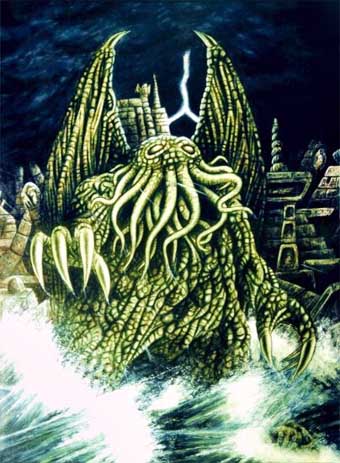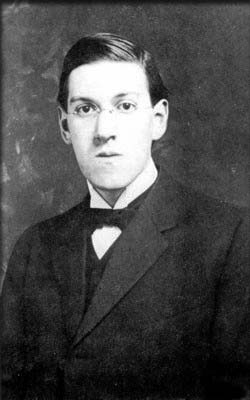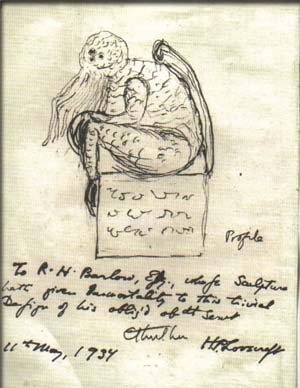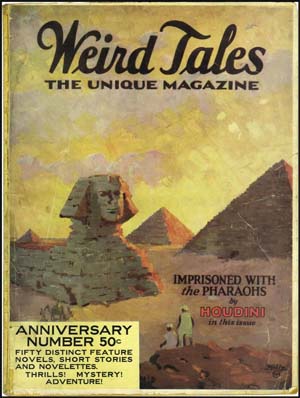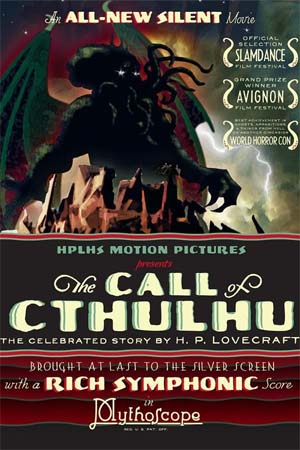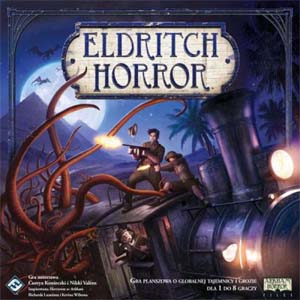pop up description layer
HOME
Cryptozoology UFO Mysteries Aviation Space & Time Dinosaurs Geology Archaeology Exploration 7 Wonders Surprising Science Troubled History Library Laboratory Attic Theater Store Index/Site Map Cyclorama
Search the Site: |
|
H.P. Lovecraft's World of Horror His stories have influenced much of modern horror, yet he died in poverty, a figure unknown but to a very few. Who was this author whose terrifying, tentacled monsters have has inspired popular culture from Hell Boy to Pirates of the Caribbean? Who was H.P. Lovecraft? Howard Phillips Lovecraft was born on August 20, 1890, in Providence, Rhode Island. His father, Scott Winfield Lovecraft, was a traveling salesman handling jewelry and precious metals. His mother, Sarah Susan Phillips, could trace her ancestry a far back as 1631 and the Massachusetts Bay Colony. Early Years Lovecraft clearly had a difficult time growing up. When Howard was only 3 years old, his father became psychotic (possibly as the result of syphilis), and had to be placed in the Providence psychiatric institution until his death five years later. Making things worse, Howard was a sickly child, who did not regularly attend school until the age of eight. However, his grandfather encouraged him to read and provided him with such classic books as The Arabian Nights and children's editions of the Iliad and the Odyssey. He also often told young Howard gothic stories of horror of this own devising.
As a writer Lovecraft was a bit of a prodigy as he began penning poems by age six. Fascinated with chemistry and astronomy by age nine he publishing his own limited run magazine The Scientific Gazette. He never graduated from high school, however, as he had a "nervous breakdown" his final year and never received a diploma. As an adult Lovecraft became a recluse, avoided most social contact and never found regular employment after he finished school. A mismanagement of his grandfather's estate left him poor and he was to struggle financially for the rest of this life. Lovecraft also suffered from sleep paralysis, a sleep disorder where the person is paralyzed and suffers from terrifying hallucinations. He claimed he felt he was assaulted at night by horrific "night gaunts" which were probably a product of these hallucinations. As you might guess, all this turmoil in his life made Lovecraft a pretty unhappy person and much of it came out in his writing. Perhaps his most famous work is The Call of Cthulhu which the story of a cult which tries to revive the demi-god monster, Cthulhu, from where he sleeps in the depths of the sea despite the monster's total disregard for humanity and the likelihood of his wakening will bring civilization to an end. The short story contains so much of what is characteristic of Lovecraft's work: a giant godlike monster with tentacles; primitive, peoples with connections to the supernatural that civilized man has forgotten, and the idea that the greater cosmos has a total indifference to the fate of humanity. Lovecraft published his first story, The Alchemist, (for which he didn't get paid) in the United Amateur Press Association in 1916. Several years in 1922 Lovecraft had his novelette, Herbert West-Reanimator, serialized in the magazine Home Brew. This time he got paid, but only five dollars for each of the six installments. Lovecraft was inspired by the American writer Edgar Allen Poe and there are a number of parallels in their life stories. Both were not really recognized as the great writers until after their deaths. Both struggled financially for their entire lives. Both past away in their 40's. After his mother died in an institution in 1919, Lovecraft met Sonia Greene while at a writer's convention of in Boston. Despite his aunts disapproval they married and he moved to her apartment in Brooklyn where she ran a successful hat shop. In New York Lovecraft joined the so-called Kalem Club which gave him a circle of intellectual and literary friends. They encouraged him to submit his stories to such publications such as Weird Tales.
When his wife lost her business and became ill, he attempted to support her, but had few marketable skills and could only find work as a low-level clerk. Green eventually recovered, but was forced to move to Cincinnati, and later to Cleveland to continue her career. Lovecraft did not go with her and lived unhappily in Red Hook and Brooklyn Heights alone until he returned to Providence in 1926. Productive Period in Providence It was during this period that, despite his unhappiness, Lovecraft was his at this most productive and produced many of his most influential works. In September of 1926 he finished The Call of Cthulhu. Next year, early in 1927, he finished his only novel The Case of Charles Dexter Ward though it wasn't published in his lifetime. In the story Ward is confined to an insane asylum and upon his escape his doctor attempts to track him down only to find Ward is not actually Ward, but a resurrected ancestor of Ward, named Curwen who is a mass murder and alchemist. Later that year Lovecraft also wrote the short story The Colour Out of Space. While often we associate Lovecraft with horror, the truth is that he also dabbled in science fiction. In this story a meteorite lands in the New England country-side and an alien entity slowly destroies the surrounding land and drives a farmer and his family mad. In 1928 Lovecraft penned The Dunwich Horror in which cultists plan to open a gateway between our dimension and the next that would allow Yog-Sothoth, a cosmic entity, to enter our universe (with disastrous consequences for the human race). The Dunwich Horror, along with The Call of Cthulhu, are considered core stories in Lovecraft's Cthulhu Mythos. The Whisperer in Darkness was published in 1931. In this novella Lovecraft tells the tale of a man living in Townshend, Vermont, who finds himself besieged with the Mi-go, an extraterrestrial race of fungoid alien creatures, who wish to keep their presence on Earth a secret.
In March of 1931 Lovecraft finished writing the novella At the Mountains of Madness the story of explorers who find the remains of a gigantic ancient alien city deep in the Antarctic. At first they believe the city is dead but eventually come in contact with some of its horrific survivors. Lovecraft's novella The Shadow Over Innsmouth (also part of the Cthulhu Mythos) was finished in December of 1931. In the story the curious protagonist visits the decaying fishing town of Innsmouth, Massachusetts, to discover that the inhabitants are interbreeding with a fish-like frog men living in the seas. The children of these matings appear human, but with "queer narrow heads with flat noses and bulgy, stary eyes." As time goes by these individuals become more and more fishlike, eventually leaving the land to live their extended lives in the depths of the sea. As the protagonist tries to leave the town with knowledge of this secret, he chased by an angry mob, one of the few examples of an action sequence written by Lovecraft. Scholars have suggested one of themes of this story, the slow devolving of man into lessor creatures, may have been influenced by Lovecraft's own fear of losing his mind, as did his parent's, who spent their last few years in a mental institution. Racism and Xenophobia In fact, Lovecraft, it seems, feared many things. Raised in isolated, primary Anglo-Saxon community he could not abide foreigners or people of difference races or religions. While many people these days find little to like in his xenophobia and racism, these fears did drive his writing down different paths other writers did not take. In his novelette At the Mountains of Madness his characters experience revulsion at finding themselves in an ancient dead city in Antarctica populated by indescribable monsters. Letters to friends suggest that this may well reflect the time he spent in the Red Hook district of New York City with the "monstrous" immigrants and peoples of different races he did not like or understand living around him. In The Lurking Fear Lovecraft's hero finds the source of a series of murders is a family of inbreed, hillbillies living underground who have regressed to almost apelike beasts. Again there are parallels here to Lovecraft's fear of people he did not feel comfortable with who seem to him almost like a lower form of life.
While never financially successful, Lovecraft was well respected by other writers and maintained substantial correspondence with his peers. Though never meeting him in person, Lovecraft was especially close to Robert Ervin Howard, best known for his short stories in the sword and sorcery subgenre about Conan the Barbarian. Lovecraft was deeply affected by Howard's suicide in 1936. Other writers also employed Lovecraft as a ghost writer. Zealia Bishop, a romance writer, hired him to write several tales including the short story The Mound in which Lovecraft brilliantly describes an ancient civilization existing under deep underground in America's mid-west. He was also hired by J. C. Henneberger, the founder and owner of Weird Tales, to write a story in the first person as Harry Houdini, the famous escape artist and magician. The story, original titled, Under the Pyramids (but published as, Imprisoned with the Pharaohs) tells of Houdini's kidnapping by cultists in Egypt. In the story, Houdini later escapes after witnessing sacrifices to a hippopotamus-sized, five-headed, tentacled beast deep inside a secret underground temple. Houdini liked the story so much he hired Lovecraft to work with him on several other projects before the magician's death in 1926. Lovecraft also encouraged other writers to make use of items, creatures and locations from his Cthulhu Mythos, in their own work. The fictional town of Arkham and its Miskatonic University were often used by other authors along with the Necronomicon (a fictional grimoire written by the "Mad Arab" Abdul Alhazred). Infuence on Films and Gaming Though Lovecraft was virtually unknown during his lifetime, his popularity has slowly grown in the years after his death from cancer in 1937. Filmmakers have turned many of his stories into motion pictures such as The Dunwich Horror (1970), Dagon (2001) and The Color Out of Space (2010). He has also influenced the thinking and design on movies not made directly from his works, such as Hellboy (2004).
His fantasy universe has also invaded the gaming world with such board games as Eldritch Horror, Elder Signs and Mansions of Madness where players can play Lovecraft type characters charged with preventing the world from being destroyed by Lovecraft type monsters. IF you want you can even buy Cthulhu as a charming puppet. Despite Lovecraft's influence on horror, he remains a controversial figure. The World Fantasy Awards, established in 1975, used a bust of Lovecraft as their award (nicknamed the "Howard"). Concerns stemming from Lovecraft's racism and xenophobia, however, caused the award to be changed in 2015 to a fantasy character. What can we make of this strange man whose racism and xenophobia also seemed to inspire his dark writing? We probably need to admit that though Lovecraft was a brilliant author, he was not without his flaws and sometimes we just need to accept the people we admire often have feet of clay. Copyright 2016 Lee Krystek. All Rights Reserved. |
|
Related Links |
|
|



